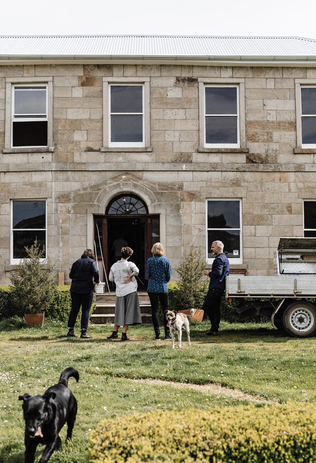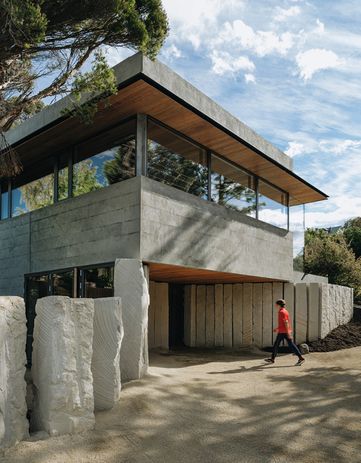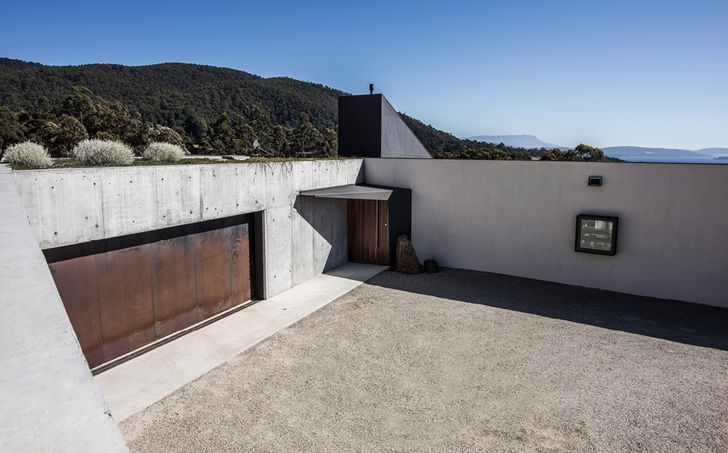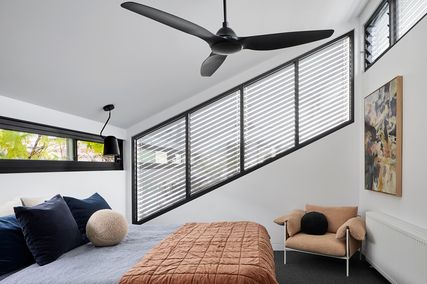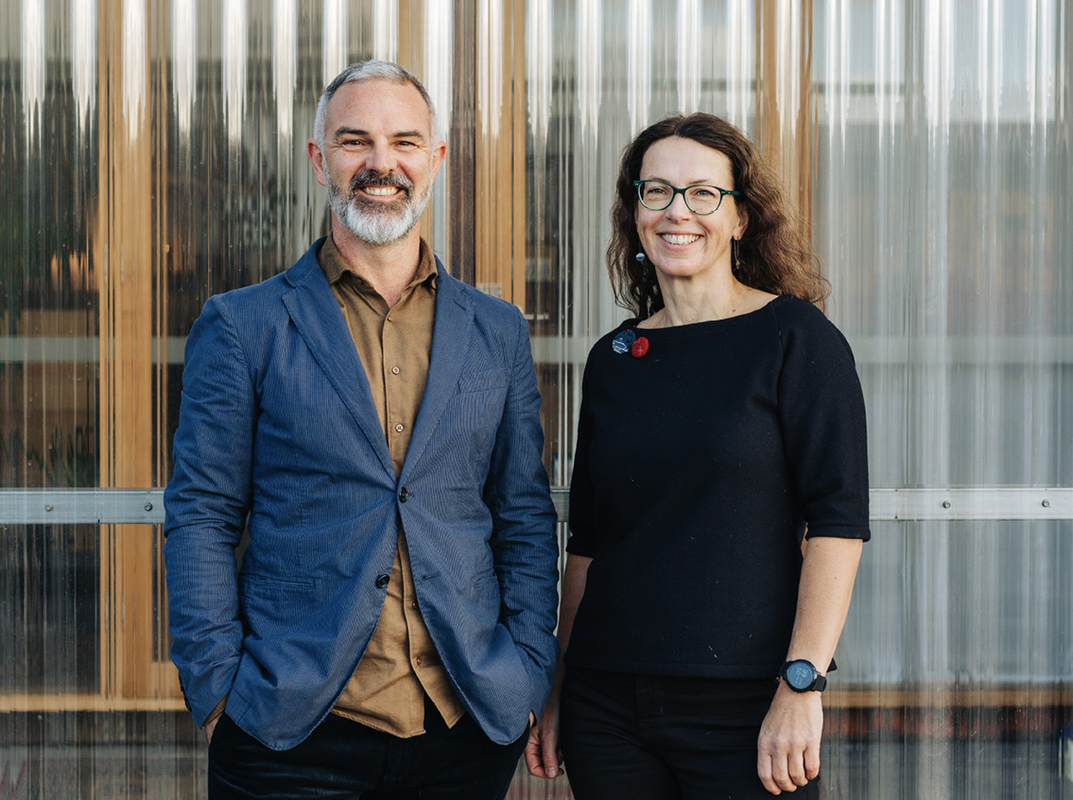At Hollow Tree House, so named because a hollowed trunk on this 1830s Tasmanian rural property once served as a post box, Core Collective Architects removed sheaths of aged wallpaper to reveal, and subsequently retain, colonial-era paintwork layered like a palimpsest. On one section of the wall, a worker had scrawled his name before applying the wallpaper, leaving a ghost-like presence that was discovered by Core Collective and their collaborators almost two centuries later. “We stripped away the paper but we left his name,” recalls practice director Ryan Strating. “For me that’s what makes history real – the feeling of the person. The people who put it together.”
Core Collective Architects’ work on that two- storey Georgian sandstone homestead (2019; see Houses 137) – a combination of restoration, structural intervention and conversion – saw the Hobart-based practice named joint winner of the Lachlan Macquarie Award for Heritage Architecture at the 2020 National Architecture Awards. More heritage work has since come their way, particularly on the grand old homesteads spread across Tasmania’s north. Yet the tag “heritage architect” sits uneasily with Ryan, and a close look at Hollow Tree House reveals why. While stripping away the accretions of time to lay bare the building’s original Georgian bones, the practice also adapted the old structure and materials to accommodate a distinctively contemporary kitchen. Bespoke furnishings and extroverted Italian lighting were chosen by the design-savvy client, and the stables converted into guest rooms. Though most of the twentieth-century additions were removed, a 1950s green terrazzo hearth was judiciously retained in the kitchen.
Old and new have been elegantly integrated at Hollow Tree House (2019), a converted Georgian sandstone homestead.
Image: Adam Gibson
Much like British architect David Chipperfield, who enjoys working on restoration projects not as a “restoration expert” but as a modern architect, Ryan’s architectural allegiances are with mid-century modernism, particularly the “robust simplicity” he values in the work of Roy Grounds. Heritage, as a form of recaptured time, holds little interest for him. His attraction to Tasmania’s Georgian legacy is not so much romantic as analytical. “My curiosity is more about how they put things together, and about the durability and longevity of materials, than their antiquity or ‘oldness’,” he says.
The practice’s work on Hollow Tree House deepened its appreciation of pre-modern building techno-logies and materials, and informed the design of Ryan’s own home, Cascade House (2020; see Houses 141). “I like simple, robust forms that will age gracefully; and I like to feel confident that the building will not flake, peel, leak, distort or require significant improvement for a couple of centuries,” he says.
When Ryan first saw the site – thought to be the backyard of the old Female Factory commandant’s cottage, with vestiges of a convict-picked sandstone wall – he imagined a house of concrete and stone emerging from the landscape. It was the potential of working with deep geological time that most intrigued him. “I thought the building should be solid and elemental like a cave, with generous openings for light; that it should be grounded in the landscape and offer refuge and comfort.” From the ground floor, surrounded by textured timber and smooth, mottled renders, a concrete staircase leads upstairs to a living room with expansive views through wrap-around windows. The sense of prospect is offset by a mood of retreat and enclosure due to the combination of timber, concrete and rendered brick walls.
The entry to Cascade House is lined with pillars formed from local sandstone.
Image: Adam Gibson
Ryan studied architecture at Deakin University, and graduated with a strong allegiance to the emerging environmental imperative. “How do you make a building responsive to the environment – achieve high thermal performance and reach sustainability goals – and still make it beautiful, elegant, comfortable, calming? That was the challenge as I saw it,” he says. After a stint at Woods Bagot, he began a deeper exploration of environmentally sensitive building at a time when it was yet to shake off the “nuts and berries” aesthetic of the 1970s. “There was a lot of mud brick, heavy timber and inelegant materials,” he recalls.
In 2002 he established Core Collective Architects in the Melbourne suburb of Brunswick with Ceridwen Owen, a graduate from the Mackintosh School of Architecture at the Glasgow School of Art. Ceridwen was completing a doctorate in sustainable architecture at the University of Melbourne and had been offered a position at the University of Tasmania. Ryan, at the same time, had decided to move to Hobart “purely out of love for the place. Everyone said it would be commercial suicide.” And so, almost by osmosis, Core Collective became a Tasmanian-based practice.
Ceridwen and Ryan’s ambition was to marry sustainable building to the ideals of elegance and simplicity, humanity and habitability, shared by early modernism and classicism. They certainly weren’t looking for heritage conversions. But the work came their way in the form of the cavernous Press Hall at the Art Deco-era Hobart Mercury building, which the practice transformed into the light and open space that would become Franklin restaurant and Pigeon Whole Bakery. The material palette of trowelled and off-form concrete, steel and Tasmanian oak is a celebration of the building’s existing fabric.
Core Collective Architects thinks of each project as a collaboration with a client rather than the imposition of a design ethos on a client, and most clients find the practice through word-of-mouth. Sunnybanks House (2016; see Houses 119) followed these serendipitous lines: a chance conversation in Sydney with a couple contemplating retirement in Tasmania led, over the course of a few years, to a commission on an elevated site overlooking the D’Entrecasteaux Channel. The clients wanted a house designed to accommodate their love for music and the many album covers they’d framed. “The idea is that the building should allow you to hear and feel this music and see this artwork all together, in concert,” Ryan says. The building sits low into the landscape, with a green roof, expressively arrayed steel inside and out, and a protected courtyard. The windows, all triple glazed, allow the broad – almost industrial – interior space to be passively warmed during sunny stretches of the boisterous Tasmanian winter. The smaller square puncturing windows to the wild south-east recall those of Le Corbusier’s Ronchamp.
Sitting low in the landscape, Sunnybanks House wraps around a protected courtyard.
Image: Adam Gibson
Two coastal residences in Victoria reveal different, yet related, responses to the constraints and possibilities of site. Venus Bay House (2006), on 18 acres of banksia and tea tree forest, rises from a north-facing dune to take in panoramic views through a continuous band of elevated windows. The building is necessarily robust, built to meet extreme fire risk construction codes, with an irregular facade of patchwork-like corrugated iron. The interior features blackbutt timber salvaged from the St Kilda pier kiosk, which burnt down in 2003. Dromana House (2018), meanwhile, is organized around a more formal contrast between a bluff, street-facing exterior of corrugated iron and spotted gum and the glazed northern facade, which frames ocean views that extend the length of the house.
Looking back at Core Collective Architects’ 20-year evolution, Ryan says Hollow Tree House marked a turning point. He is now inclined to see the heavy yet harmonious colonial Georgian aesthetic as a precursor of a type of “textural modernism” that is equally robust, and enduring. Instead of the faceless glass box appended to a heritage building, the practice is pursuing a more elegant integration between old and new – a subtler response that brings out the contrasts between building styles separated by two centuries, and the affinities too.
But over and above nuances of style, aesthetics and even environmental performance, the team is drawn today to a more fundamental question when designing a new building or converting an old one: “What does the heart want?” corecollective.com.au
Source
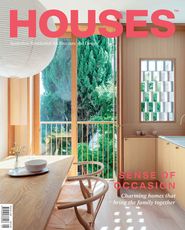
People
Published online: 21 Oct 2022
Words:
Luke Slattery
Images:
5828,
Adam Gibson,
Derek Swalwell
Issue
Houses, October 2022


